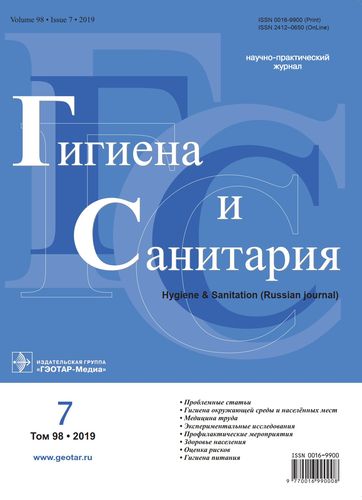Clinico-electroneuromyographic study in miners with occupational polyneuropathy of the upper extremities
- Authors: Gidayatova M.O.1, Yamshchikova A.V.1, Fleishman A.N.1
-
Affiliations:
- Research Institute for Complex Problems of Hygiene and Occupational Diseases
- Issue: Vol 98, No 7 (2019)
- Pages: 713-717
- Section: OCCUPATIONAL HEALTH
- Published: 15.07.2019
- URL: https://rjraap.com/0016-9900/article/view/639621
- DOI: https://doi.org/10.47470/0016-9900-2019-98-7-713-717
- ID: 639621
Cite item
Full Text
Abstract
Introduction. Among the various methods of diagnosis and prediction of peripheral nerve injuries of the upper extremities, stimulation electroneuromyography plays a significant role. Occupational polyneuropathy of the upper extremities in coal miners is a common pathology. This pathology can lead to a disability of the active population, which makes the problem to be socially significant. Stimulation electroneuromyography is a method of choice in the diagnosis and prediction of peripheral nervous system diseases.
Material and methods. 40 miners aged from 42 to 65 years, employed in hazardous working conditions (vibration, physical overload, gas pollution, adverse climatic conditions) were surveyed. As a control group, 12 healthy subjects of the same age without the signs of peripheral nervous system disease were examined. A clinical and electrophysiological study was conducted, including a clinical investigation, a quantitative assessment of subjective complaints on the Total Symptom Score (TSS) scale and stimulation electroneuromyography.
Results. Occupational polyneuropathy developed in all surveyed workers employed in adverse working conditions; it was characterized mainly by myelinopathies of motor and sensory nerve fibers. In the clinical picture there were dominated sensitive (95%) and painful (45%) manifestations, moderately pronounced, the average score on the TSS scale was of 2.63 and 2.44, respectively; a correlation relationship between neurophysiological indices and subjective complaints (r-Pearson criteria value accounted of from 0.75 to 0.97) was revealed. Prenosological manifestations of electroneuromyography changes were detected in 5% of the examined subjects.
Conclusion. The study of the functional state of peripheral nerves by using the method of stimulation electroneuromyography is an effective tool for the early diagnosis of occupational polyneuropathy.
About the authors
Margarita O. Gidayatova
Research Institute for Complex Problems of Hygiene and Occupational Diseases
Author for correspondence.
Email: samodurova.margarita@mail.ru
ORCID iD: 0000-0002-8003-036X
MD, postgraduate student of the Laboratory of applied neurophysiology, neurologist, Research Institute for Complex Problems of Hygiene and Occupational Diseases, 23, Kutuzova Str., Novokuznetsk, 654041, Russian Federation.
e-mail: samodurova.margarita@mail.ru
Russian FederationA. V. Yamshchikova
Research Institute for Complex Problems of Hygiene and Occupational Diseases
Email: noemail@neicon.ru
Russian Federation
A. N. Fleishman
Research Institute for Complex Problems of Hygiene and Occupational Diseases
Email: noemail@neicon.ru
Russian Federation
References
- Rusanova D.V., Katamanova E.V., Lakhman O.L., eds. The use of electroneuromyography in the clinic of occupational diseases: A training manual. [Primenenie elektronejromiografii v klinike professional’nyh zabolevanij: Uchebnoe posobie.] Irkutsk: RIO IGMAPO; 2018. (in Russian)
- Kochetova O.A., Mal’kova N.Y. Clinical and epidemiological description of the occupational polyneurophathy. Zdorov’ye – osnova chelovecheskogo potentsiala: problemy i puti ikh resheniya. 2013; (8-1): 402-4. (in Russian)
- Kosarev V.V., Babanov S.A., eds. Occupational diseases [Professionalnye bolezni]. Moscow: GEOTAR-Media, 2010. (in Russian)
- Kolesov V.G. Electromyography in the diagnosis of vibration disease. Meditsina truda i promyshlennaia ekologiia. 1999; (2): 8-12. (in Russian)
- Rukavishnikov B.C., Kolesov V.G., Shayakhmetov S.F., Pankov V.A. Musculoskeletal disorders in mining workers in the northern regions. Meditsina truda i promyshlennaia ekologiia. 2004; (2): 6-11. (in Russian)
- Izmerov N.F., ed. Guidelines on occupational diseases. [Rukovodstvo po professional’nym zabolevaniyam]. 2. Moscow: Meditsina; 1996. (in Russian)
- Rusanova D.V., Lakhman O.L. Electroneuromyography in diagnosis of vibration disease and occupational polyneuropathy. Meditsina truda i promyshlennaia ekologiia. 2007; (6): 31-6. (in Russian)
- Murata R., Araki S., Okajima F., Nakao M., Suwa K., Matsunaga C. Effects of occupational use of vibrating tools in the autonomic, central and peripheral nervous system. Int. Arch. Occup. Environ. Health. 1997; 70(2): 94-100.
- Asbury A.K., Gilliatt R.W., eds. Peripheral nerve disorders. London: Butterworth&Co.Ltd; 1984.
- Komantsev V.N., ed. Methodical basis of clinical electroneuromyography. Guidelines for physicians. [Metodicheskiye osnovy klinicheskoy elektroneyromiografii. Rukovodstvo dlya vrachey]. St. Petersburg; 2006. (in Russian)
- Kasatkina L.F., Gilvanova O.V., eds. Electromyographic research methods in the diagnosis of neuromuscular diseases. Needle electromyography. [Elektromiograficheskiye metody issledovaniya v diagnostike nervno-myshechnykh zabolevaniy. Igol’chataya elektromiografiya]. Moscow: Medika; 2010. (in Russian)
- Levin O.S., ed. Polyneuropathy. Clinical guidelines for physicians. [Polinevropatii. Klinicheskoye rukovodstvo dlya vrachey]. Moscow: MIA; 2016. (in Russian)
- Nikolaev S.G., ed. Atlas on electromyography. [Atlas po elektromiografii]. 2-nd ed. Ivanovo: PresSto; 2015. (in Russian)
- Ziegler D., Hanefeld M., Ruhnau K.J. et al. Treatment of symptomatic diabetic peripheral neuropathy with the antioxidant alfa-lipoic acid. A 3-week multicentre randomized controlled trial (ALADIN Study). Diabetologia. 1995; 38(12): 1425-33.
- Rusanova D.V., Lakhman O.L. Efficiency of using electroneuromyography in diagnostics of occupational diseases. Byulleten’ VSNTS SO RAMN. 2013; (3): 34-9. (in Russian)
- Sandén H., Jonsson A., Wallin B.G., Burström L., Lundström R., Nilsson T. et al. Nerve conduction in relation to vibration exposure - a non-positive cohort study. J. Occup. Med. Toxicol. 2010; 5: 21.
- Lotti M., Becker Ch.E. Occupational peripheral neuropathies. West. J. Med. 1982; 137(6): 493-8.
- Fazdalova M.R., Khayrullina L.Kh. Polyneuropathy from exposure to industrial vibration and physical overload. Translyatsionnaya meditsina. 2018; 5(S3): 356. (in Russian)
- Gekht B.M. Theoretical and clinical electromyography. [Teoreticheskaya i klinicheskaya elektromiografiya]. Leningrad: Nauka; 1990. (in Russian)
- Gnezdilov A.V., Syrovergin A.V., Zagorulko O.I., Ovechkin A.M., eds. Electroneuromyographic diagnostic technique in a modern clinic. [Tekhnika elektroneyromiograficheskoy diagnostiki v sovremennoy klinike]. Moscow: Nauka; 2003. (in Russian)
- Katamanovа E.V., Nurbaeva D.J. Mathematical approach to the diagnosis of expression degree of occupational polyneuropathy. Mezhdunarodnyy zhurnal prikladnykh i fundamental’nykh issledovaniy. 2016; (11-1): 71-5. (in Russian)
Supplementary files









